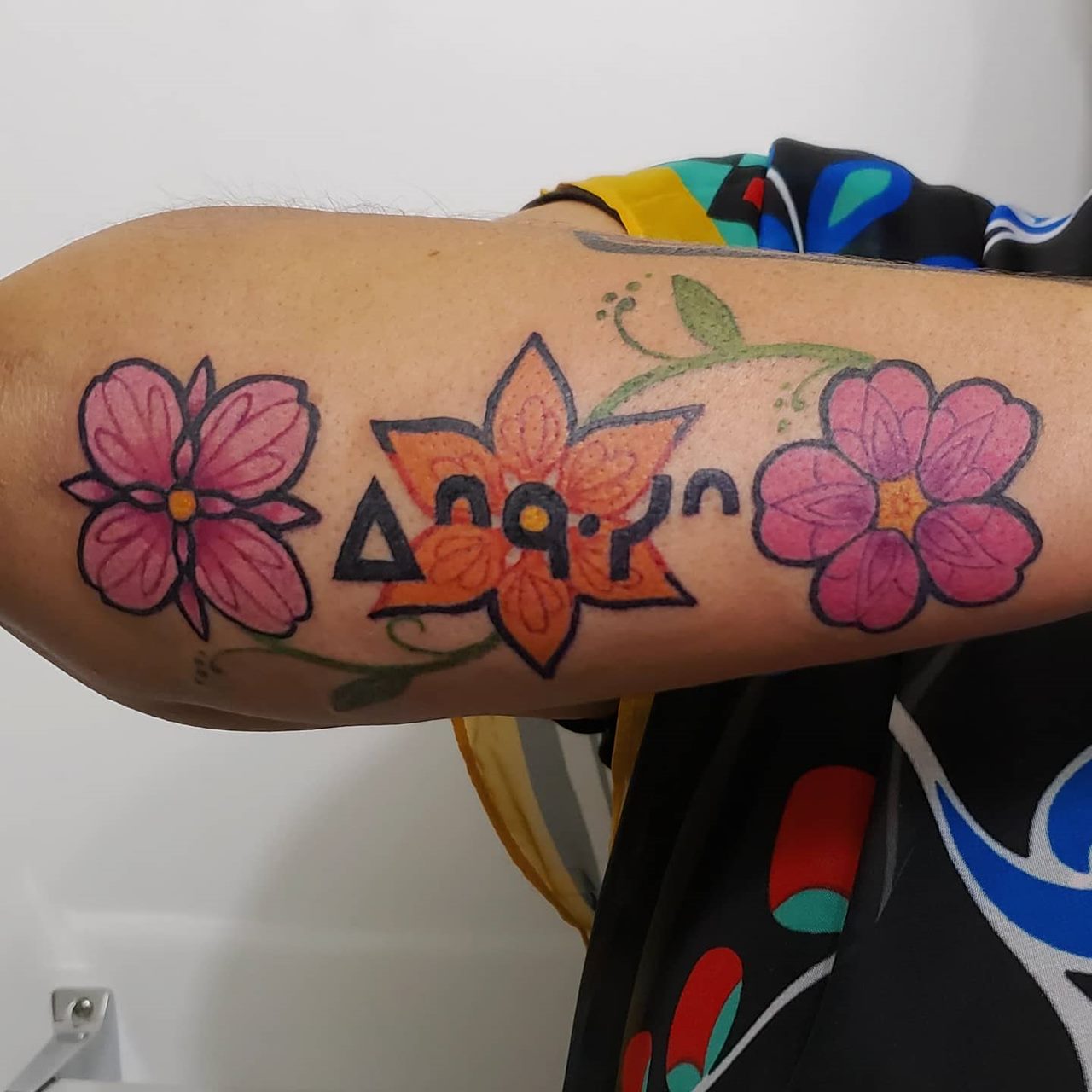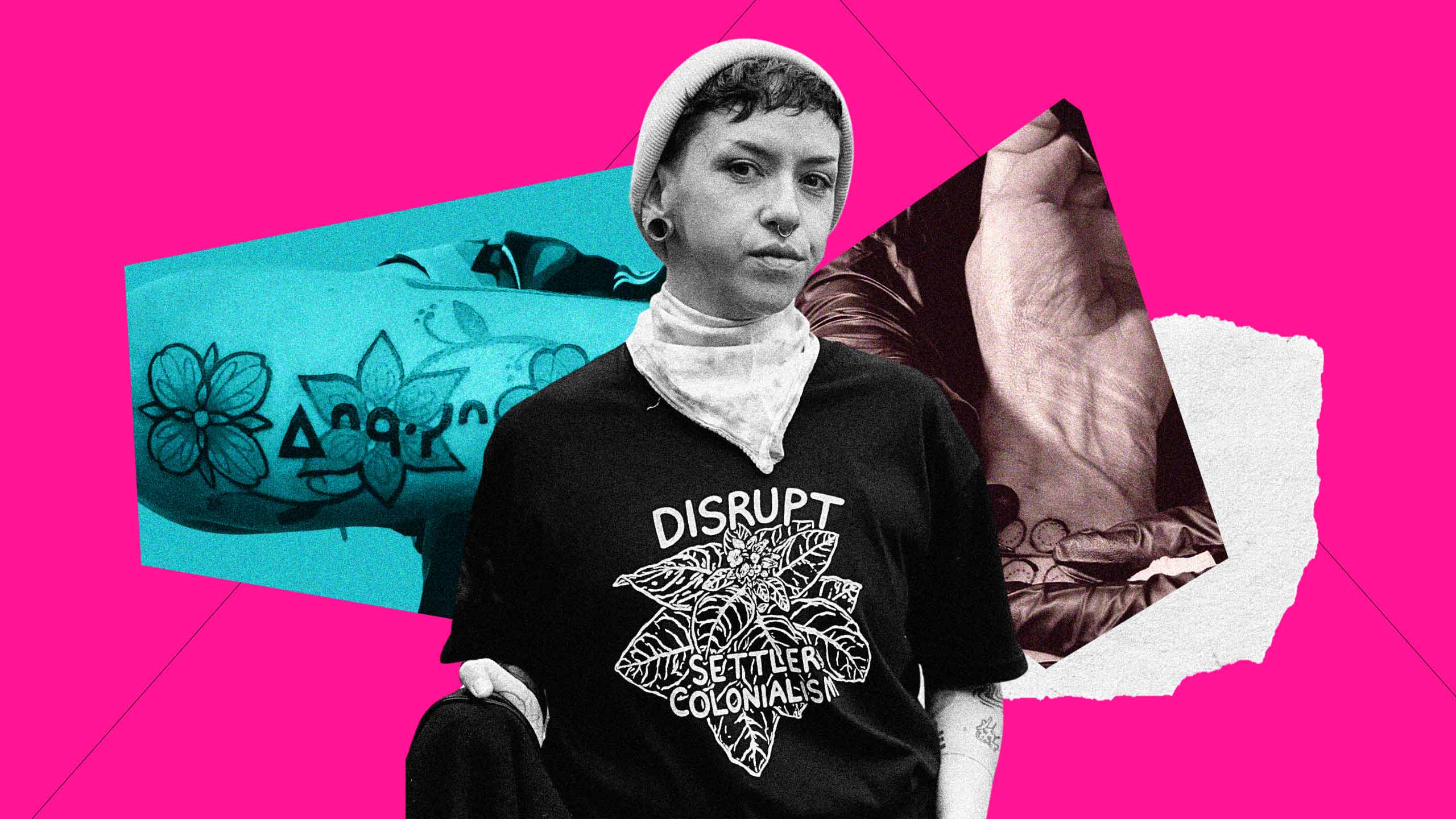From pink triangles to pansies, pop culture to politics, tattooing and queerness go hand in hand. Queer Ink is a seven-part series on queerness and tattooing, where we’ll dive deep into the ways that queer and trans people use tattooing to embody ourselves and identities.
Here, we look at how Two-Spirit artists are using tattooing to bring their own identities and histories to the forefront.
Indigenous communities across North America—and around the world—have rich histories of traditional tattoos, bringing together art, medicine, honour and celebration in the practice of putting ink on skin.
In recent decades, the Indigenous tattoo revival movement has been gaining momentum, fuelled by a generation of artists determined to preserve this knowledge and keep the art alive in their communities.
And many artists are finding entirely new ways to express Indigenous culture and pride through tattoos. In this artistic and cultural climate, Two-Spirit artists are bringing their own identities and histories to the forefront—drawing on tradition and legacy to explore gender, sexuality and evolving Two-Spirit roles in their designs and practices.
“When I see anyone who is getting into revitalizing a cultural artistic practice, I’m just so excited, because Indigeneity is a living, flowing, changing thing,” says Sheri Osden Nault, a Two-Spirit tattoo artist currently based in Ontario. “How they are choosing to engage with their culture is what’s keeping that living flow moving into the future. It’s a form of Indigenous futurism, to practise that.”
Nault themself first started tattooing nearly a decade ago, doing hand-poke (also known as stick-and-poke) tattoos on themself and their friends.
Over the years, they became more and more curious about cultural tattoos and Indigenous practices of body modification, and how that could intersect with queer and Two-Spirit identity.

Tattooer Sheri Osden Nault Credit: Sheri Osden Nault
“Something that is very present for both queer and Indigenous communities, when it comes to tattooing, is that often, due to different life circumstances, we find ourselves in situations where we don’t have the level of bodily autonomy that, ideally, we would have—that we might like to have; that we might need to have,” says Nault. “So, getting tattooed, choosing to alter or mark your body in a way that you have a lot of autonomy and control over, can be very empowering.”
Many of Nault’s own tattoos—including a recent throat tattoo of a single black-outlined triangle—embrace traditional designs through a deliberately Two-Spirit world view.
“The throat tattoo is in some documentation of historic Cree tattooing—it’s based on something documented, but there would be more triangles, and they would be filled in,“ says Nault. “And in this colonial documentation process, it’s referred to as a ‘men’s warrior tattoo.’ So, choosing to have that on myself, as someone assigned female at birth, also has this genderqueering of the practice.”
Nault, in turn, invites people to come get tattoos from them in a space they can trust will be consent-informed and queer-affirming—often at gatherings of Indigenous tattooers, working alongside other Two-Spirit artists in the space.
“I’m very open and forward about being Two-Spirit,” they say. “Oftentimes, my bio for a tattoo gathering will say ‘I’m Two-Spirit, and you have to be okay with that if you’re receiving tattoo medicine or markings from me.’ Then Two-Spirit individuals will seek me out because they feel like I’m someone who will be a safer experience.”
For Nault, embracing traditional tattoos doesn’t mean sticking only to documented designs.
They cite Dion Kaszas, a mentor and a pillar of the Indigenous tattoo revival movement, who teaches that bringing back these practices means being free to experiment and evolve.
“If our people hadn’t been forced by colonization to stop tattooing, what kinds of markings and embellishments would we have been making for ourselves?” says Nault, repeating a concept they learned from Kaszas that has had a deep impact on their practice.
For fellow Two-Spirit tattoo artist Tristen Sanderson, based in Edmonton, Alberta, creating new Indigenous art has always been a passion.
“My dad was always saying, ‘My girl, you should be an Indigenous artist,’” Sanderson recalls. “‘That’s what you should do. Mark my words—that’s what you’re going to do. Unfortunately, he didn’t get to see me be an artist and a tattoo artist in this physical realm. But I know he knows it did happen.”
Sanderson learned tattooing from her family, picking up her first tattoo needle at age 14.
“My stepdad had made a homemade machine,” she says. “He was tattooing his friends and his brothers, and I thought, ‘That looks so cool.’ Because I was always drawing eagles and wolves, he said, ‘You should try it out. You’re always drawing that kind of stuff.’”

One of Tristen Sanderson’s pieces. Credit: Tristen Sanderson
Sanderson also wanted to learn more Indigenous tattooing practices and traditional Cree designs. She’s been able to find examples of Indigenous tattooing from around the world through her own research—but her own familial history with tattooing was harder to track down.
“My dad used to talk about how my great-great grandmas had their chin markings,” she says. “I would ask, ‘Oh, what’s that?’ But he didn’t know all too much either.”
Now a professional tattoo artist in her own right, Sanderson has been studying traditional Cree tattoos—and has married her love for those traditions with her Two-Spirit identity, making space for people to explore gender norms and self-expression through tattoos.
“I do a lot of florals and really bright colours,” she says of her tattoo designs. “I love being able to share that beauty with everyone. Unfortunately, there’s this perception in society that florals are only for girls. People will say, ‘Do you have anything more masculine? I’m a man, so florals are not for me.’ And I say, ‘Flowers are here for everyone.’”
When she does traditional tattoos, on others or on herself, Sanderson says the experience always stops her in her tracks.
“It is really beautiful to feel connected with my ancestors and the ways they used to do things” she says. “It’s powerful, to feel like it’s not gone and it’s not lost.”
For both Sanderson and Nault, tattooing is a form of medicine—healing, as well as art.
“I do think of it as medicine, and I take that to heart,” says Sanderson. “I always smudge before I do a tattoo, and I always try to come at it in a good way. And if I’m not having too great of a day, I will reschedule people, because I feel like the energy and the space that I’m holding for people should be good.”
And practising tattoos as medicine also means being rigorous about consent, autonomy and safety practices during the whole process, Nault adds.
“We don’t want to do harm while we’re working on empowering people,” they say.
And when she looks toward the future of the Indigenous tattoo revival movement, Sanderson hopes to see more Two-Spirit artists picking up the inks and needles and bringing their own medicine and artistic vision to the work.
“To people wanting to come into the tattoo industry—especially other Indigenous youth—don’t give up,” says Sanderson. “Follow true to your art, and don’t let anybody else sway you. Because we need more Indigenous tattoo artists out here, and especially Two-Spirit artists.”
Inside the Queer Ink series …
Series editor Mel Woods introduces the history behind queer and trans people and tattooing, and dives into how tattooing has played a key role in their own life and identity. (Oct. 2, 2023)
Lindsay Lee Wallace explores the A Thousand Pansies Project, an initiative to use tattooing as queer collective care. (Oct. 4, 2023)
Xtra staff share the stories behind some of our own gayest tattoos. (Oct. 10, 2023)
Adam Rhodes dives deep into erotic tattoos and the queers who choose to get them. (Oct. 12, 2023)
BJ Ferguson explores the world of post-op top surgery tattoos. (Oct. 17, 2023)
Julia Peterson profiles some of the Two-Spirit tattooers using the artform to express and explore identity.
Next up: In our series finale, we spotlight some queer and trans artists across Canada to inspire your next tattoo.


 Why you can trust Xtra
Why you can trust Xtra


